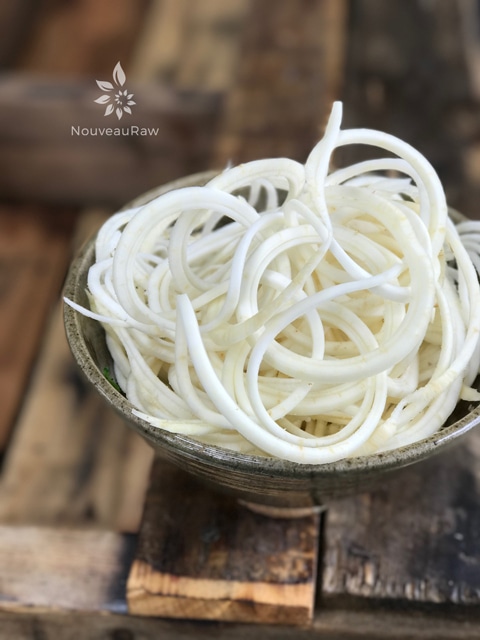
~ raw, vegan, gluten-free, nut-free, alkaline ~
Celeriac root is often referred to as the ugly root, turnip-rooted celery, knob celery, or celery root. The exterior is rough, knobby, and covered with tiny rootlets. Avoid large, over-matured roots and those with surface cracks. Basically, this veggie wouldn’t win any veggie pageants when it comes to the looks department.
I know they can look scary but remember you are bigger than it is. (my dad always said that when I screamed “ Dad, SPIDER!” With your courage in one hand and a good sharp knife in the other, it is time to tackle the task set before you.
Nutrient Powerhouse
It is high in protein, vitamins, and minerals. Celeriac has high contents of vitamin C and is a splendid source of vitamin-K. It also has various B vitamins such as thiamine (B1), riboflavin (B2), niacin (B3), pantothenic acid (B5), and vitamin B6. It is rich in calcium, iron, magnesium, manganese, phosphorus, potassium, sodium, and zinc.
Because it is a wonderful source of both soluble and insoluble fiber (soluble fiber forms a gel-like substance in the gut) and is slightly bitter, it naturally aids in digestion and metabolism. The potassium content is said to be highly effective for cleansing the kidneys too. The benefits don’t stop here, but I do… I want to give you enough information to spike your interest in researching it more, but I also don’t want all your time here…. spent reading… we have noodles to make!
Does it taste good?
I find the creamy white flesh to be delicious, crispy, and firm. It features a nutty, earthy, sweet, subtle celery flavor, with a hint of celery and parsley lingering in the background. So yes, it does taste good. Celeriac root pairs well with apples, carrots, and beets.
Cautionary Note – Celeriac contains several furanocoumarin compounds such as psoralen, bergapten, xanthotoxin, and isopimpinellin which may cause skin burn (photo-toxicity) in some sensitive individuals. Moreover, like celery, it should be avoided in large quantities in pregnant women. For those who are on diuretic medications and anticoagulant medications… use this root sparingly due to Vitamin K.
 Ingredients:
Ingredients:
- Celeriac root, trimmed & peeled
Preparation:
- To prepare, just scrub and wash the root in cold running water to remove off surface sand and soil.
- Pat dry using an absorbent cloth.
- Trim off at top and base.
- You want to remove the leaves, stalks (if they are still on there), the entire brown hairy exterior and get down to the light flesh. You can use a paring knife or potato peeler.
- It is best to peel celeriac just before use since, like potatoes or apples, they will start to brown when exposed to air.
- Place the spiralizer unit on the countertop and press down on it to engage the suction cups and secure.
- Insert the blade cartridge you’d like to use, make sure that it clicks into place.
- Cut flat ends on each end of the root.
- Place the center of the celeriac root onto the cylinder part of the blade and press the teeth of the handle into the other side of it.
- Take hold of the handle on the bottom (the horizontal one) with one hand and then spin the handle with the teeth to spiralize. Press steadily with forward pressure, using the handle that you’re gripping, for best results.
- Before dressing up the noodles, take scissors when you’re done spiralizing and cut the noodles into manageable size pieces. Just grab a bunch of noodles and roughly snip. Or enjoy that never-ending noodle!
- You can make noodles in advance, they should keep for 5-7 days in the fridge, without sauce.
- Toss with lemon juice before storing though as they will darken in color when exposed to air.
- It can be boiled, braised, steamed, roasted, or eaten raw.
To clean the spiralizer:
- Purchase an inexpensive handled brush for cleaning the blade parts and hard to reach parts on the unit. This will save your fingers and prevent nicks from happening on the blades, keeping them nice and sharp.
- Be sure to quickly rinse the unit after creating noodles. The juices from certain root veggies can stain the unit.
- Dry the blades well before putting them away.
Tools used to create noodles:
GEFU Spiralfix Spiral Slicer 13410 $49.95
GEFU Spiralfix Spiral Slicer
- Can be used in the left or right hand.
- 4 different widths of cut for creative recipes: Spiral cut across the entire width of the material, 3 mm, 6 mm, or 12 mm wide adjustable via adjusting wheel
- Folding lid for easy filling
- Detachable non-slip holding container for safe standing
- Material: stainless steel, ABS plastic, SAN
- Splash-guard lid with drive unit detachable for easy cleaning. Dishwasher-safe
Spiralizer 7-Blade Vegetable Slicer
- This slicer comes with 7 different blades which give you 7 completely different textures and shapes.
- Comes with 420 high carbon cutlery grade stainless steel blades and stronger making it possible to Spiralize harder root vegetables like sweet potatoes and turnips that previously broke Spiralizer handles
Potato Peeler
- Wash and peel the outer skin off of the veggie.
- Hold the veggie at one end and in a long stroke motion, run the peeler from top to bottom.
- Rotate the veggie in a circular motion and continue peeling until you reach the seeded core (if there is one). Stop once you reach this. Don’t throw it away, use it in a smoothie or salad.


 Add to favorites
Add to favorites
 Ingredients:
Ingredients:
I cannot wait to try this!!! Celery root is one of my favorite things. I bet it’s so yummy this way.
Good morning Jack. I love celeriac noodles too. I hope you enjoy them! amie sue